Americans have seen Comco Ikarus‘ C42 before. At least three different importers have represented C42 versions to the U.S. market. Today, Germany’s most successful light aircraft is served by a Canada-based dealer, Ikarus Flight Centre.
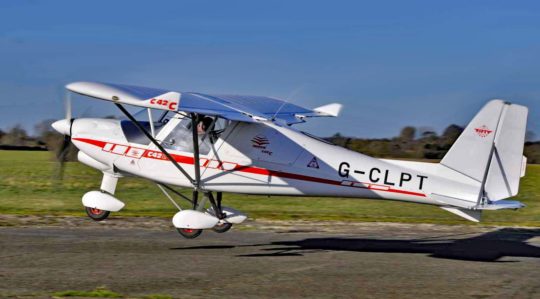 Yet no one can dispute that C42 — once rebadged as Cyclone for American buyers — has for many years been THE success story in Germany. This southern German company celebrated its 50th anniversary in 2020.
Yet no one can dispute that C42 — once rebadged as Cyclone for American buyers — has for many years been THE success story in Germany. This southern German company celebrated its 50th anniversary in 2020.
Our favorite British aerojournalist, Dave Unwin is back with another of his imaginatively written and thorough pilot reports. As some of us get ready to head to Sun ‘n Fun 2021, those still unable or unwilling to travel can enjoy this while I gear up for stories from Lakeland, Florida. Enjoy! —DJ
Comco Ikarus C42C
The air is like glass as the C42 accelerates into a winter sky in the United Kingdom. I took this proven, affordably-priced light aircraft aloft to evaluate flight qualities on the newest iteration of the design.

In England, C42 is sold by The Light Airplane Company (TLAC); boss Paul Hendry-Smith reviewed for me many changes on the newest “C” model.
C42A first flew in 1996 later maturing from C42B to the C, which first appeared in 2015.
More than 1,450 C42s have been delivered, and the type makes up a substantial part of the UK’s microlight fleet. Some have logged more than 8,000 hours.
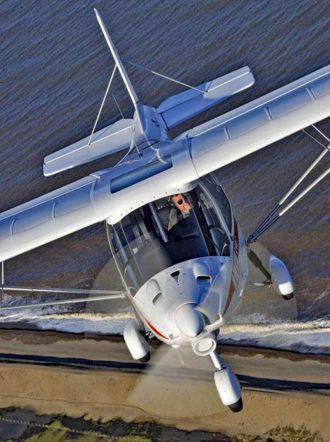
Note inlet below prop; closed in this view.
Tried and true elements stayed the same. Power is still provided by a 100 horsepower Rotax 912S turning a composite three-blade fixed-pitch Helix prop although the Germany company lists the 80-horsepower version as standard. One easily-noticed difference is that the cowl now features a controllable flap for the air inlet (photo).
Fuel is carried in a single 17.2 U.S. gallon fuel tank made from roto-cast polyethylene located immediately behind the right seat; filling is done via a cap on top of the fuselage. An auxiliary tank is an option, which takes total fuel capacity to 100 liters (26.4 gallons).
The airframe is constructed primarily of aircraft grade aluminum and is covered with non-structural molded composite sections, with all the strength in the large aluminum boom. The fit & finish of the composite panels is excellent. Comco Ikarus have invested heavily in CNC-made molds which produce composite panels to a very high standard.
C42C’s strut-braced wings use tubing spars front and rear but this latest model features a sharper leading edge plus winglets. The airfoil has also changed and with it, an overall drag-reduction program was instigated. C42C now has various panels to reduce drag and wingroot fillets between the fuselage and flaps, which have a slight upward reflex of about negative-5° for higher-speed cruise. Interestingly, the differential ailerons now feature spades, commonly found on aerobatic aircraft to enhance roll response.
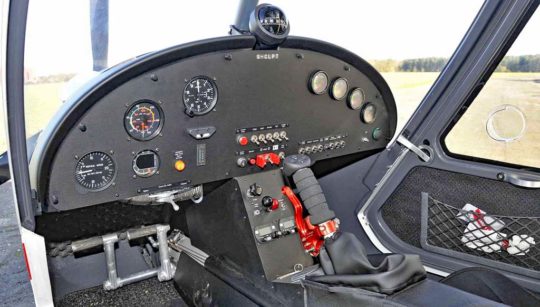
C42C’s tail consists of a strut-braced tailplane and separate elevator, a slightly swept-back vertical stabilizer, which carries a broad-chord rudder and a small ventral fin tail bumper. Wings, tail, flaps and control surfaces are all covered in XLAM (a type of sturdy, dimensionally-stable fabric sailcloth) with Tanara Teflon thread (which is impervious to UV light) used for the stitching.
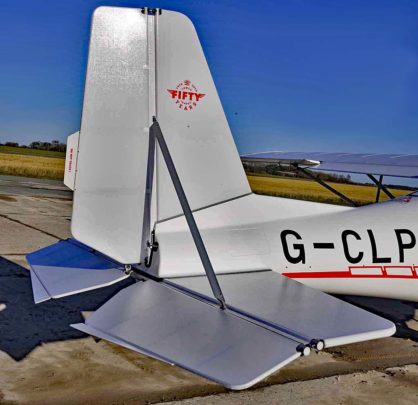
A sturdy hydro-pneumatic tricycle undercarriage offers nosewheel steering via the rudder pedals and carries Beringer wheels and hydraulic disc brakes. Unusually, the main gear and nosewheel are the same size. All C42C controls work via pushrods, except the rudder which uses cables.
The A model I flew in 2001 had a gross weight of 992 pounds although the design is ready to have its maximum all-up weight increased to 1,235 pounds (very similar to Canada’s Advanced Ultralight category) as soon as the legislation changes.
Big gull-wing doors and low sills make ingress easy to C42C, particularly as the doors are held up by powerful gas struts that are strong enough to allow taxiing with the doors open. Doors cannot be opened in flight but can be removed completely. Doors seal tightly. I did not detect even a slight draft, even at high speed. Neither seat nor pedals adjust.
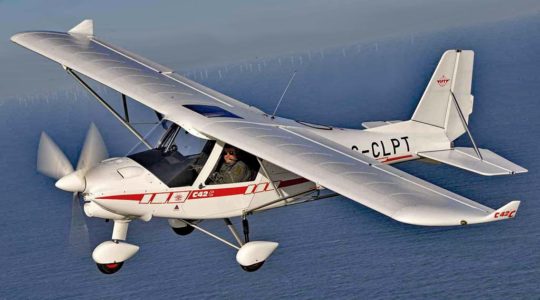
C42C’s instrument panel is large and could easily carry just about every possible permutation of instrumentation, from very basic analog to the latest Garmin G3X touchscreen, which is an option. The test aircraft has (from left to right) a VSI, ASI and altimeter, with the Kanardia tachometer directly underneath the ASI.
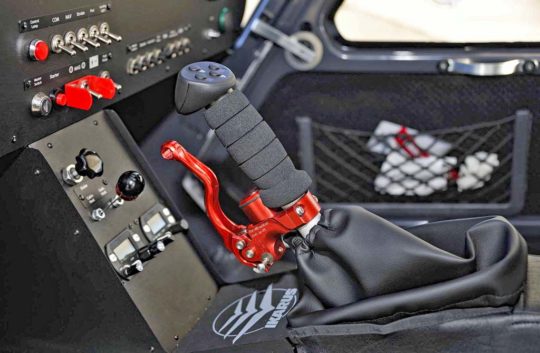
A center stick features a comfortable foam grip with buttons for electric elevator trim and a bicycle-type brake lever with integral park brake. The large handbrake-type flap lever is set into the roof, in front of a red T-handle for the BRS.
Flying C42C
Taxiing reveals good, well-damped suspension, and the turning circle is acceptable even without differential braking. C42’s Beringer brakes are very powerful.
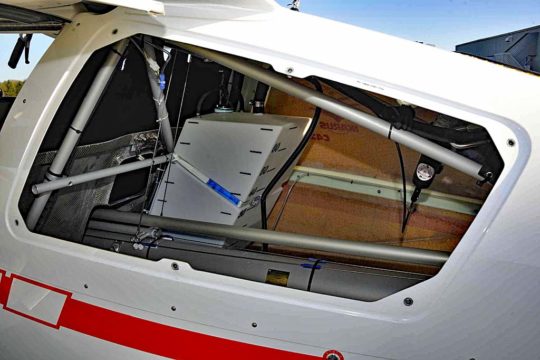
After shooting the air-to-air photos, the camera ship departed and I took a look at C42C’s general handling. All controls were nicely harmonized and authoritative. The roll rate in particular is much more sprightly than the C42A, while the stick forces felt lower than I remembered, no doubt due to the spades mounted on the ailerons. A short center stick does not provide much mechanical advantage but the spades help. Control around both pitch and yaw axes was equally effective, and keeping the slip-ball centered took only small amounts of rudder. The electric pitch trim is effective and nicely geared.
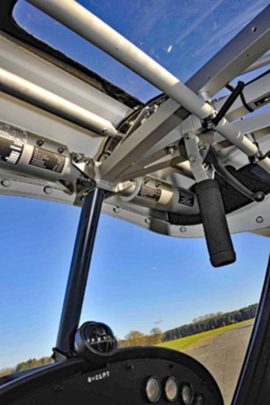
Slowing down to explore the slow speed side of the flight envelope revealed no unpleasant traits. As the speed reduced past 60 knots, I moved the flap lever to +2, which lowers the flaps to their maximum of 40° and causes a significant change in pitch trim, although this is easily trimmed out.
With full flaps and a reasonable amount of power C42C showed no desire to stall. At modest stall entry and with the nose just above the horizon, C42C mushed and wallowed while the sink rate increased. No stall warning is provided but you feel a mild aerodynamic buffet. Hold the stick on the backstop and it hunts slightly in pitch while sinking. Adequate aileron control is available post-stall.
When I used a more aggressive technique C42C stalled with a slight wing drop. At test weight, the wing drop came around 32 knots. Performing a departure stall I retracted flaps to the take-off setting of +1 (15°), opened the throttle and pitched up …and up …and up! It feels as if I’m lying on my back before the wing finally gives up and the nose falls through.
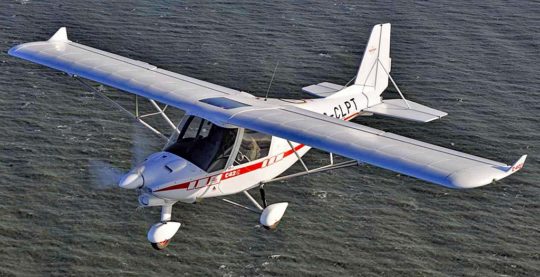
As I’d anticipated, this C42 is considerably quicker than the earlier models, and because the air is as smooth as glass I was relaxed as the ASI needle slipped into the yellow arc. C42C was still accelerating at 5000 rpm. Top-of-the-green arc is 82 knots at 2,000 feet and 4800 rpm. At about four gallons per hour, you can comfortably plan for 300 nautical miles with a 30-minute reserve. That’s about 25 nautical air miles per gallon.
As I got back to base, I did a few take offs and landing, and for the first time I found the roof-mounted flap lever slightly intrusive; you’re constantly swapping hands. It’s not a big deal, but writers have to complain about something.

Interested in float flying? Comco Ikarus has options for this kind of flying, too.
For a short-field landing trial, I used 48 knots with a hint of power. Over the runway I flared, chopped the throttle and C42C sat straight down. I applied strong braking and quickly stopped.
Going around once more, I was light, had burned off more fuel, and had cold, dense air. Climb was almost 1,400 feet per minute, even more impressive as the prop was pitched for the cruise.
When C42C can go to 1,235 pounds gross, it will boast a useful load of more than 600 pounds. At full fuel payload is more than 500 pounds. This illustrates the value of a light airframe. With eventual gross weight at 1,235 pounds (85 pounds less than nearly every LSA), C42C will have a greater payload than much more costly designs. That and a long history with commendable flight qualities makes C42C a winner.
Base price in England translates to just over $80,000 in early 2021 and the Canada dealer has similar numbers though you should contact them for the latest information. As tested, this C42C was priced at $94,000. Shipping may add another $5,000 so Comco Ikarus’ entry could come in at $90,000-100,000. Interested American should contact Ikarus Flight Centre; featured in the video below.
TECHNICAL SPECIFICATIONS
Comco Ikarus C42C
- Length — 21 feet
- Height — 7.2 feet
- Wing Span — 28.5 feet
- Wing Area — 128 square feet
- Empty Weight — 500 pounds
- Gross Weight — 1,041 pounds (with parachute allowance; weight may increase to 1.235 pounds)
- Useful load — 432 pounds (higher when new gross weight is approved)
- Wing Loading — 8.14 pounds per square foot
- Fuel Capacity — 17 gallons; optional 26 gallons
- Never Exceed Speed — 121 knots
- Cruise Speed — 100 knots
- Stall Speed (best flaps) — 34 knots
- Climb Rate — 1,200 feet per minute
- Takeoff Roll — 280 feet
- Takeoff Over 50 Foot Obstacle — 525 feet
- Landing Over 50 Foot Obstacle — 675 feet
- Powerplant —Rotax 912S air; liquid-cooled, four cylinder, 100 horsepower at 5800 rpm (an 80 horsepower Rotax 912 is standard equipment)
- Propeller — Helix composite three-blade fixed pitch
In this video from four years ago, Comco Ikarus’ North American dealer describes C42.


I live in Rimouski, Quebec, Canada. I am interested to purchase one aircraft with wheel and float. How much would it cost me and is it a kit I have to build myself and approved by Transport Canada?
Please use links in the article to contact Ikarus Flight Centre.
Hola precio por favor email borman08@hotmail com
Raúl Jiménez
Cel WhatsApp 949836712
Perú. La libertad. Trujillo
Jrn :
Paucartambo 188 4 piso.
Please use links in the article to contact Ikarus Flight Centre.
Use os links do artigo para entrar em contato com a Comco Ikarus.